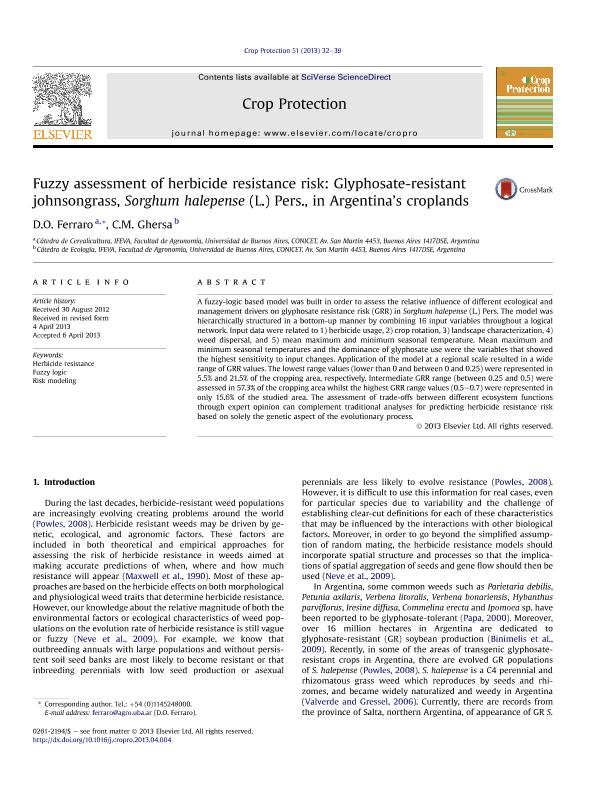Artículo
Fuzzy assessment of herbicide resistance risk: Glyphosate-resistant johnsongrass, Sorghum halepense (L.) Pers., in Argentina's croplands
Fecha de publicación:
09/2013
Editorial:
Elsevier
Revista:
Crop Protection
ISSN:
0261-2194
Idioma:
Inglés
Tipo de recurso:
Artículo publicado
Clasificación temática:
Resumen
A fuzzy-logic based model was built in order to assess the relative influence of different ecological and management drivers on glyphosate resistance risk (GRR) in Sorghum halepense (L.) Pers. The model was hierarchically structured in a bottom-up manner by combining 16 input variables throughout a logical network. Input data were related to 1) herbicide usage, 2) crop rotation, 3) landscape characterization, 4) weed dispersal, and 5) mean maximum and minimum seasonal temperature. Mean maximum and minimum seasonal temperatures and the dominance of glyphosate use were the variables that showed the highest sensitivity to input changes. Application of the model at a regional scale resulted in a wide range of GRR values. The lowest range values (lower than 0 and between 0 and 0.25) were represented in 5.5% and 21.5% of the cropping area, respectively. Intermediate GRR range (between 0.25 and 0.5) were assessed in 57.3% of the cropping area whilst the highest GRR range values (0.5e0.7) were represented in only 15.6% of the studied area. The assessment of trade-offs between different ecosystem functions through expert opinion can complement traditional analyses for predicting herbicide resistance risk based on solely the genetic aspect of the evolutionary process
Palabras clave:
Fuzzy Logic
,
Glyhosate
Archivos asociados
Licencia
Identificadores
Colecciones
Articulos(IFEVA)
Articulos de INST.D/INV.FISIOLOGICAS Y ECO.VINCULADAS A L/AGRIC
Articulos de INST.D/INV.FISIOLOGICAS Y ECO.VINCULADAS A L/AGRIC
Articulos(OCA PQUE. CENTENARIO)
Articulos de OFICINA DE COORDINACION ADMINISTRATIVA PQUE. CENTENARIO
Articulos de OFICINA DE COORDINACION ADMINISTRATIVA PQUE. CENTENARIO
Articulos(SEDE CENTRAL)
Articulos de SEDE CENTRAL
Articulos de SEDE CENTRAL
Citación
Ferraro, Diego Omar; Ghersa, Claudio Marco; Fuzzy assessment of herbicide resistance risk: Glyphosate-resistant johnsongrass, Sorghum halepense (L.) Pers., in Argentina's croplands; Elsevier; Crop Protection; 51; 9-2013; 32-39
Compartir
Altmétricas




